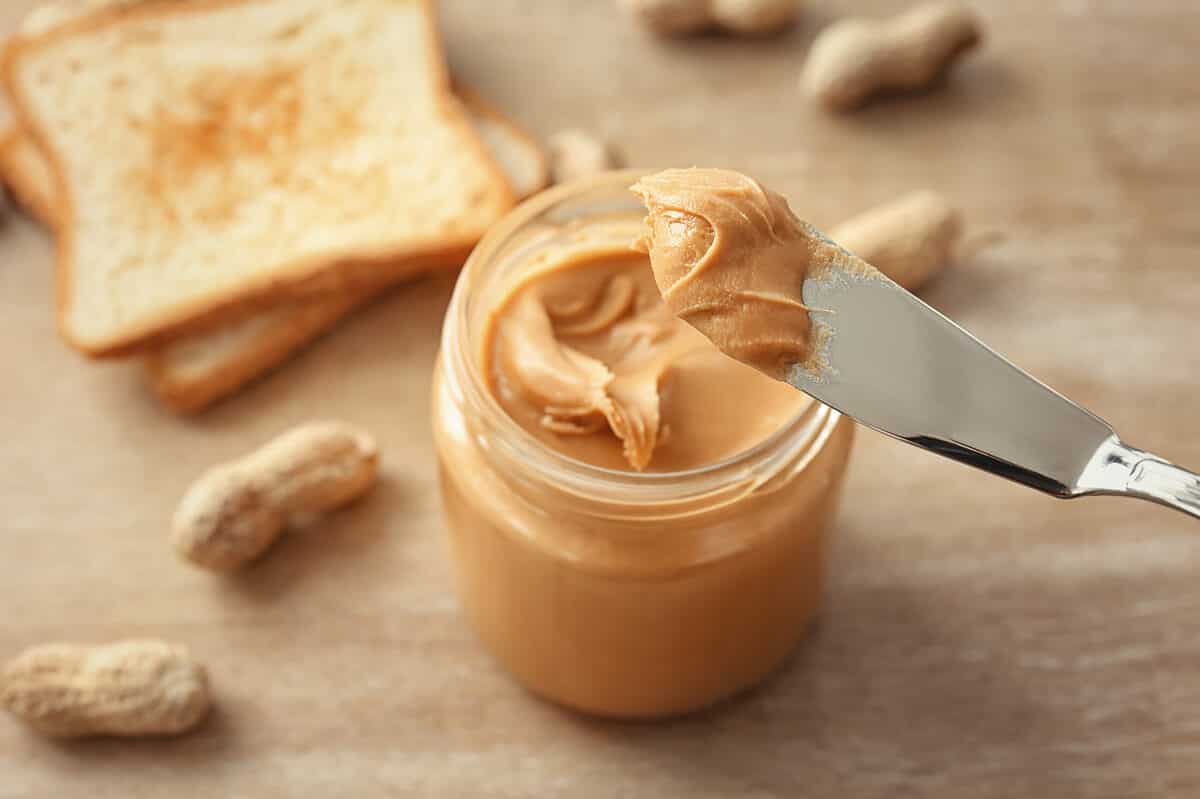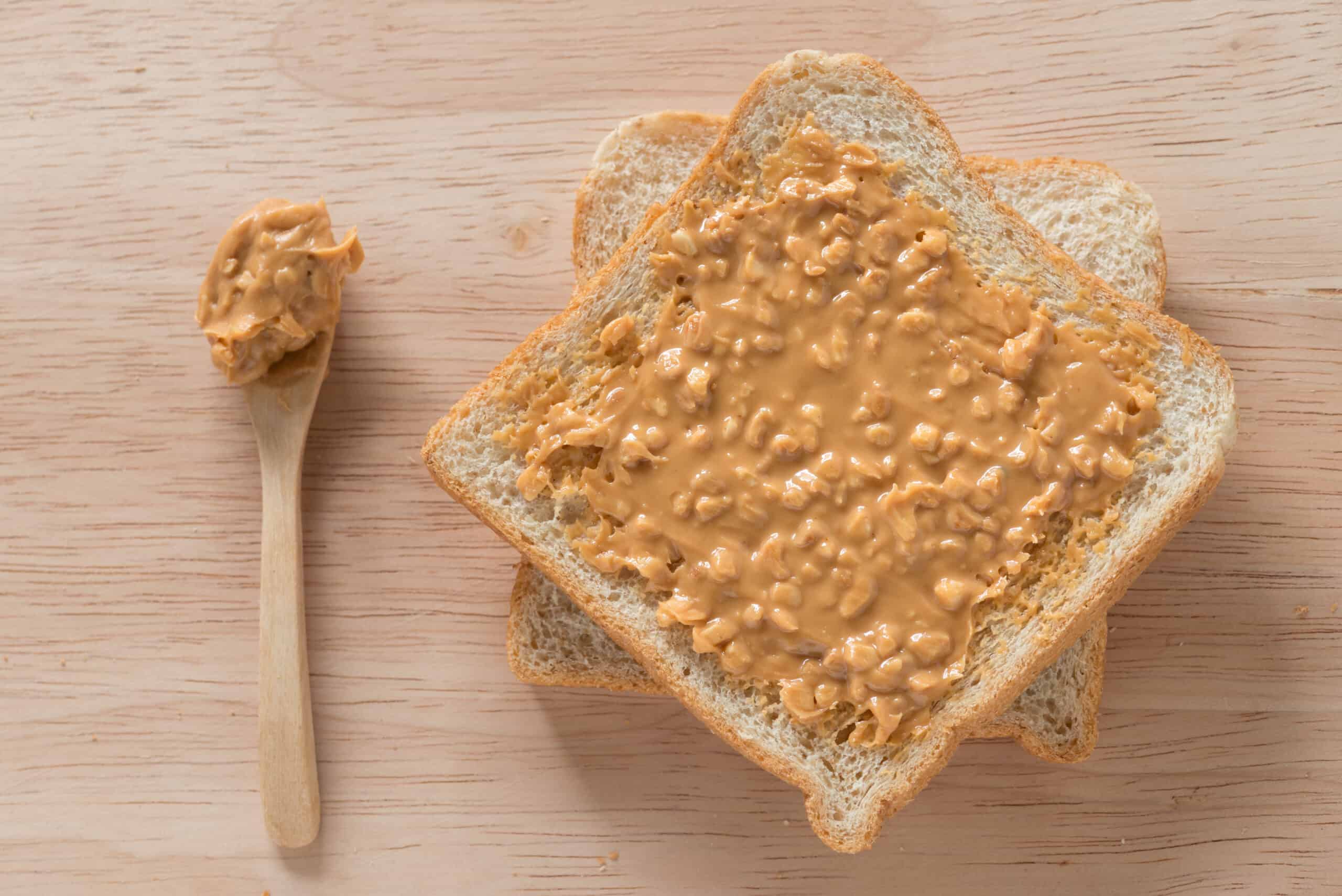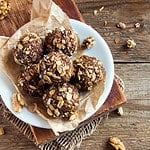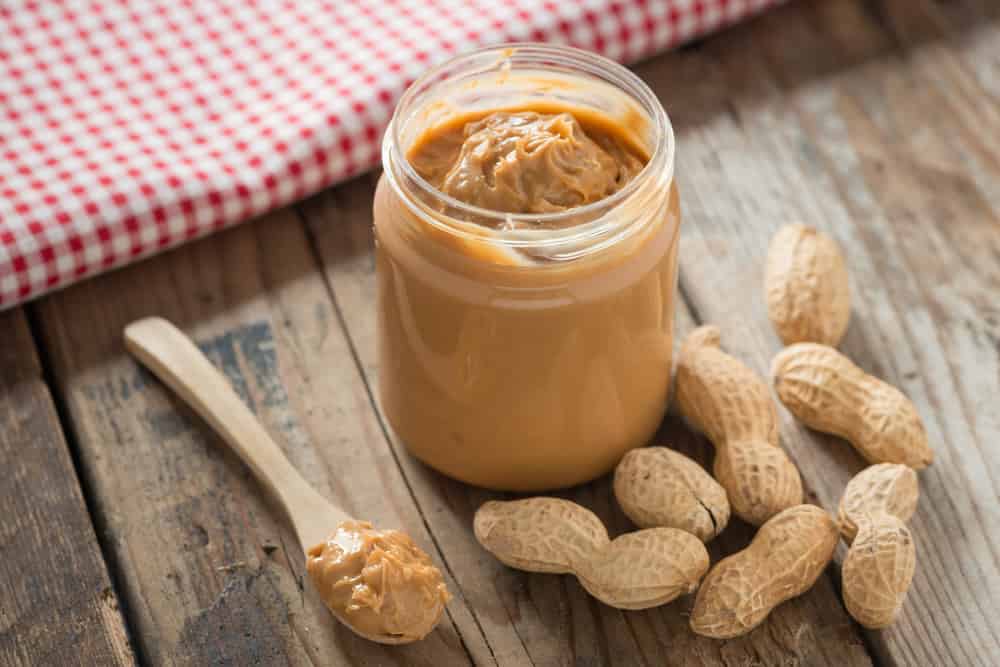Peanut butter is a staple in most homes and is something adults and kids love. It’s no wonder kids love a PB&J, but peanut butter isn’t just for sandwiches. You can use it in smoothies, spread it on toast, or drizzle it on apple slices. Peanut butter used to be considered a healthy snack, but with how popular other spreads, such as almond butter, have become, you might wonder if peanut butter is really healthy.
There are many varieties of peanut butter out there; whether peanut butter is healthy depends on the kind you choose. Keep reading to find out which kinds of peanut butter are healthiest and even some healthy alternatives to peanut butter.

Peanut butter can be a healthy addition to your meals, especially when you choose natural peanut butter.
©New Africa/Shutterstock.com
Is Peanut Butter Healthy?
There are often mixed opinions about whether peanut butter is healthy or not. While there are many known benefits to eating peanuts and other legumes (yes, peanuts are actually legumes!), there is also the concern of saturated fats and other added ingredients.
While peanut butter can be healthy, this doesn’t mean every brand of peanut butter is good for you to eat. Many peanut butter brands have unhealthy additives such as corn syrup, palm oil, and preservatives. If you’re looking for the healthiest peanut butter, there are many natural brands that include only a few ingredients.
Even though natural peanut butter brands have a shorter shelf life due to the lack of preservatives, they provide the benefits of eating peanut butter without added oil or sugar.
What’s In Peanut Butter?
Let’s first take a look at the ingredients in most peanut butter brands. Some of the major brands of peanut butter are Skippy, Jiff, Peter Pan, and Smucker’s.
The ingredients list for Peter Pan peanut butter includes Roasted peanuts, sugar, less than 2% hydrogenated vegetable oil (rapeseed and cottonseed), and salt.
While we know there are benefits to eating roasted peanuts, the most concerning ingredient is the hydrogenated vegetable oils. Even if it’s a small amount, it’s still important to understand the impacts of it.
Hydrogenated vegetable oils are often used to extend the shelf life of certain products. However, there are concerns about the negative impacts of these oils. Some of the potential side effects of a diet full of hydrogenated vegetable oils include an increased risk of heart disease, stroke, and type 2 diabetes.
If you’re concerned about harmful ingredients, you can purchase natural peanut butter like Smucker’s Natural Peanut Butter. The ingredients of Smucker’s Natural Peanut Butter include peanuts and salt.
Nutritional Value of Peanut Butter vs Other Peanut Butter
The nutritional value of peanut butter is only one piece of the puzzle when considering how healthy it is. However, the amount of fat and sugar does play a significant role in how it impacts your health. Let’s compare two peanut butter brands: Smucker’s Natural Peanut Butter and Peter Pan Peanut Butter.
Here’s a look at the nutritional value of natural peanut butter versus other peanut butter:
Two tablespoons of Smucker’s Natural Creamy Peanut Butter include:
- 190 calories
- 16 grams of fat
- 110 mg of sodium
- 7 grams of carbs
- 3 grams of fiber
- 2 grams of sugar
- 8 grams of protein
Two tablespoons of Peter Pan Peanut Butter include:
- 200 calories
- 16 grams of fat
- 125 mg of sodium
- 7 grams of carbs
- 2 grams of fiber
- 3 grams of sugar
- 8 grams of protein
Natural peanut butter includes a bit less sugar and more fiber, but the difference in nutritional values is minimal. The main difference between these two types of peanut butter is their ingredients.
While the natural peanut butter is made only of peanuts and salt, the Peter Pan Peanut Butter includes hydrogenated oil as well as added sugar. The addition of hydrogenated oil leads to a smoother texture as well as a longer shelf life.
Benefits of Peanut Butter
Even when you choose peanut butter with added ingredients, there are benefits to eating peanut butter because of the roasted peanuts. Some of the benefits of peanut butter include:
It’s Good for Your Heart
Heart health is one of the major benefits of eating peanut butter. Peanuts are high in unsaturated fats, which are beneficial to lower your cholesterol and can reduce your risk of heart disease.
Helps You Feel Full
Since peanut butter is full of protein and fiber, it helps you stay full longer than other foods. This is a great way to satisfy your appetite to avoid overeating or lose weight. A healthy snack like peanut butter with fruit or a peanut butter smoothie can be a healthy midday snack to curb your appetite.
Contains Biotin
Peanuts contain biotin, which is a necessary vitamin with many benefits. Many people choose to take a biotin supplement for the benefits biotin has for your hair and nails. Peanut butter is a good way to add some extra biotin to your diet without an added supplement or in addition to the biotin you’re already taking.
Reduces Risk of Diabetes
Peanut butter is low in carbs, which is great for those managing diabetes and can prevent a blood sugar spike. Additionally, the omega-6 in peanut butter can reduce insulin resistance. Over time, insulin resistance can lead to pre-diabetes.

Peanut butter is high in calories, with nearly 200 calories in a serving.
©inewsfoto/Shutterstock.com
Downsides to Peanut Butter
Along with the many benefits of eating peanut butter, there are also some downsides to consider. Here are some of the concerns about eating peanut butter:
Peanut Butter Is High in Fat
The fat content in peanut butter is usually the reason it’s considered unhealthy. There are many unsaturated fats in peanut butter, which are beneficial for you, but also contain saturated fat.
Saturated fat has been linked to the risk of heart disease in the past. Still, more recent studies show that there’s not necessarily a link between saturated fat and cardiovascular disease. It’s best to consume various fats instead of avoiding one type.
Peanuts Are a Major Allergy
While this won’t affect everyone, peanuts are one of the nine major food allergens. There’s no harm in eating peanut butter if you’re not allergic, but considering millions of people are allergic, it’s something to keep in mind.
Peanut allergies are most common in young children, but you can develop a peanut allergy at any time.
Peanut Butter Is High in Calories
Besides the high-fat content, peanut butter is also higher in calories than most other foods. A serving size of two tablespoons will add nearly 200 calories to your meal. That being said, peanut butter may not be the best snack for those trying to lose weight or restrict their daily intake of calories.
Healthy Alternatives to Peanut Butter
While peanut butter certainly has its place in a healthy diet, there are many healthy alternatives to peanut butter as well. Nut butters such as almond butter have become so popular that you can find them in most grocery stores.
Here are some healthy alternatives to peanut butter if you want the flavor and versatility without some of the downsides:
Almond Butter
Almond butter can be a delicious and healthy alternative to peanut butter. While almond butter, like most nut butter, is high in calories, it also has a higher content of healthy fats than peanut butter.
Cashew Butter
Cashew butter is another healthy alternative to peanut butter and is great for managing your blood sugar. It also has high amounts of magnesium, making it great for those who want the health benefits of cashews.
Sunflower Seed Butter
While sunflower seeds are nut-free, sunflower seed butter is still a healthy alternative to peanut butter. It has high amounts of iron, vitamin E, and other nutrients. It’s also high in omega-6 fatty acids, making it beneficial for heart health.
Healthy Ways to Serve Peanut Butter
If you’re a fan of peanut butter and want to know how to serve it in a healthy way, you can:
- Melt peanut butter in the microwave and drizzle it over apple slices. For an added boost of healthy fat, sprinkle the apples with chia seeds as well.
- Drizzle peanut butter on top of a yogurt bowl, smoothie bowl, or acai bowl for added protein.
- Add peanut butter to a healthy smoothie recipe.
- Spread peanut butter on a slice of whole-grain toast.
Recipe Card
These are all great and healthy ways to enjoy peanut butter, whether you choose natural peanut butter or a peanut butter alternative. While they aren’t as healthy, there are also many ways to enjoy desserts made of peanut butter for a protein boost. Check out one of our favorite peanut butter recipes below!
Print
Peanut Butter Energy Balls
- Total Time: 10 mins
Ingredients
- 1 cup of oats
- 1/2 cup of natural peanut putter
- 1/4 cup of honey
- 1 tbsp of chia seeds
- 1/4 cup of chocolate chips
Instructions
- Mix all ingredients together in a bowl.
- Roll into balls.
- Refrigerate for at least 1 hour before eating.
- Prep Time: 10 mins
- Cook Time: 0 mins
- Category: Snack
- Method: No-Cook
- Cuisine: American
The image featured at the top of this post is ©inewsfoto/Shutterstock.com

